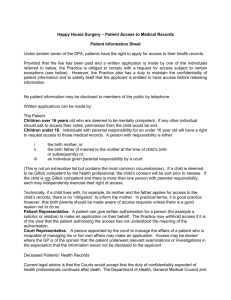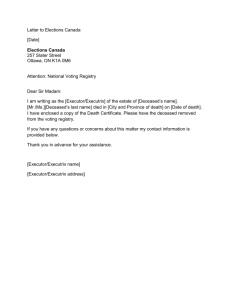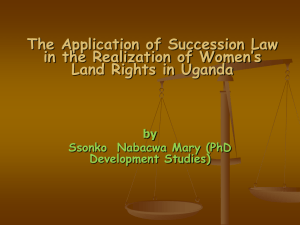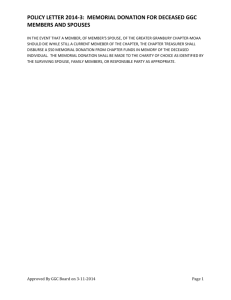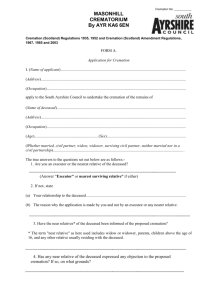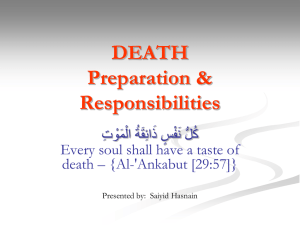15. mpala
advertisement
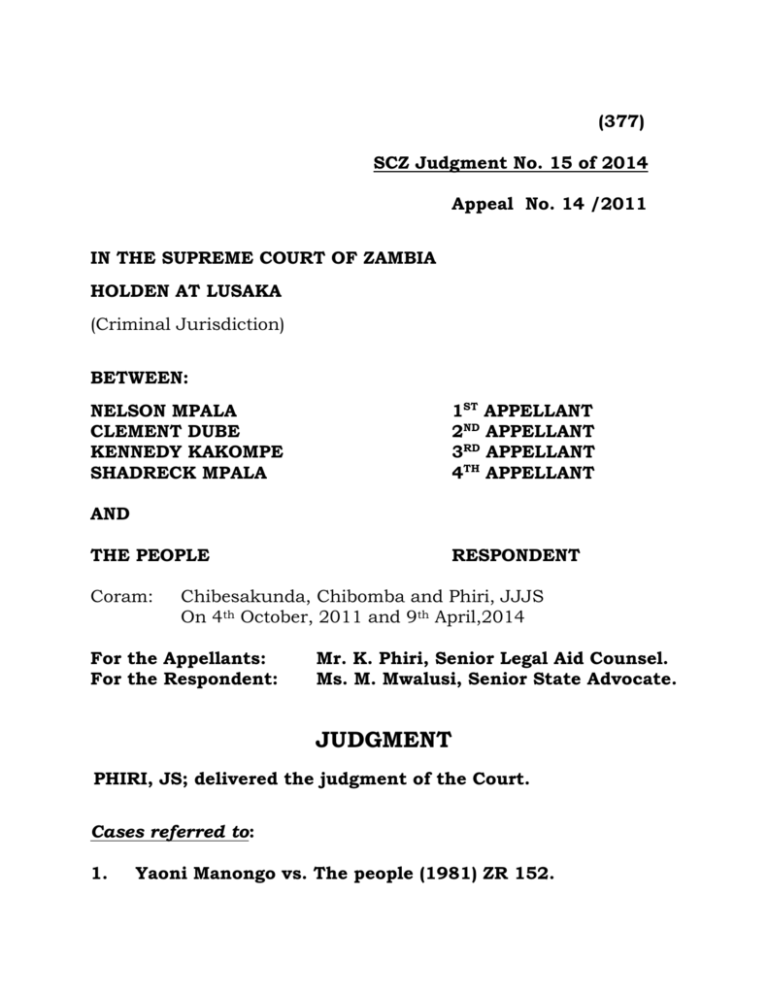
(377) SCZ Judgment No. 15 of 2014 Appeal No. 14 /2011 IN THE SUPREME COURT OF ZAMBIA HOLDEN AT LUSAKA (Criminal Jurisdiction) BETWEEN: NELSON MPALA CLEMENT DUBE KENNEDY KAKOMPE SHADRECK MPALA 1ST APPELLANT 2ND APPELLANT 3RD APPELLANT 4TH APPELLANT AND THE PEOPLE Coram: RESPONDENT Chibesakunda, Chibomba and Phiri, JJJS On 4th October, 2011 and 9th April,2014 For the Appellants: For the Respondent: Mr. K. Phiri, Senior Legal Aid Counsel. Ms. M. Mwalusi, Senior State Advocate. JUDGMENT PHIRI, JS; delivered the judgment of the Court. Cases referred to: 1. Yaoni Manongo vs. The people (1981) ZR 152. (378) 2. Benson Phiri and Sammy Mwanza vs. The People (2002) ZR 107 3. Jack Chanda and Another vs. The people SCZ Judgment No. 29 of 2002. The four (4) appellants; Nelson Mpala, Clement Dube, Kennedy Kakompe and Shadreck Mpala were sentenced to suffer death following their conviction by the Lusaka High Court which tried them on an information containing one Count of the capital offence of Murder contrary to Section 200 of the Penal Code, Chapter 87 of the Laws of the Republic of Zambia. The particulars of the offence were that the appellants, and two others who were subsequently acquitted, on the 18th day of January, 2010 at Lusaka in the Lusaka District of the Republic of Zambia, jointly and whilst acting together, did murder Collins Shakunkuma; herein referred to as the deceased. The prosecution’s case in the Court below, was based on the evidence of six (6) witnesses; namely, Betty Lupiya Shamilimo (PW1); Godfrey Dube Shambwa (PW2); Maliku Kaimana (PW3); Kennedy Lupiya (PW4); Felix Lupiya (PW5) and No. 5674 J2 (379) Detective/Inspector Edward Mambwe (PW6). In the Judgment of the lower Court, Felix Lupiya was erroneously referred to as PW4. This witness is shown as PW5 in the record of proceedings; and in this Judgment we shall refer to him as such. Kennedy Lupiya was equally erroneously referred to as PW3, when he was PW4. We shall refer to him as such. The evidence of PW1 was that on the morning of the 18 th of January, 2010, between 04.00 hours and 05.00 hours, whilst in her bed, she received a mobile phone call. When she opened the line, the caller said “Collins come here at Nampundwe, I am dying”. Thereafter, the line was immediately cut. Collins, the deceased, was her biological son from the previous marriage. PW1 called back; and Nelson Mpala (A1) answered the phone and confirmed to have apprehended the deceased for allegedly having stolen money amounting to K50,000.00, cash. Nelson Mpala (A1) was her step son from her current husband. PW1 made a follow up and found the deceased at Shadreck Mpala’s house. The deceased was tied up with a chain and was being J3 (380) assaulted all over his body by A1, A2 and A4. The assailants used cattle leashes and a stick. While at the scene, PW1 saw Kennedy Kakompe (A3), also known as Mungule, emerge. A3 was known to her as a Neighbourhood Watch vigilante. A3 poked the deceased in the stomach area with a short baton before asking what he had done. The deceased stated that he had stolen some money. PW1 observed that the deceased was very weak and was unable to stand and walk. She offered to give the deceased some food and better clothes before they could take him to the Police Station and the Clinic. At the advice of A3, PW1 proceeded to her home to prepare food and better clothes; but a short while later, she learnt from a good Samaritan, that her son had been abandoned and left for dead by the roadside. She rushed to the scene and found the deceased lying down motionless; she observed whip bruises all over his body and his hair had been pulled off. PW1 knew all the appellants and was related to A1, A3 and A4. She was married to A1’s father. The evidence of PW2, was that on the same date, but between 09.00 hours and 10.00 hours, he found the deceased being assaulted by J4 (381) A1 and A2 at A4’s house. The assailants used a stick and whips. A1 and A2 also pulled off the deceased’s hair in the process of the assault. He further observed that the two had tied the deceased up with a cattle leash and a chain. When A4 came to the scene, he teamed up with the rest of the appellants and continued to assault the deceased. Later, A3, Kennedy Kakompe also joined and kicked the deceased in the stomach. A3 later purported to take the deceased to the Police Station; which was his task as a member of the Neighbourhood Watch group; but as it were, the deceased was found abandoned and left for dead by the roadside. PW2 observed that the deceased was unable to walk; his skipper was torn; he had fresh injuries all over his body, and his hair had been cut off his head. The evidence of PW3 was that on the same day, at about 12.45 hours, she was on her way to the Hospital, when she found the deceased lying down by the roadside Bus Station. She recognized the deceased and phoned his mother, PW1. She later returned to the school where she worked. J5 (382) The evidence of PW4 was that on the same day, around 13.00 hours, he went to the roadside where he found the deceased lying down, motionless. He also found PW1, PW2 and PW5 attending the scene. PW4 reported the incident to the nearest Police Station. He later identified the body of the deceased to the Doctor who conducted the postmortem examination at the Hospital. The evidence of PW5 was that around 05.00 hours on the material day, his mother, PW1, informed him of the cell phone call she received to the effect that his brother, the deceased, had been accused of having stolen K50,000.00 cash belonging to the first appellant. He contacted the first appellant, who confirmed the information. He later advised the first appellant to take the deceased to the Police Station. When he returned from the fields, he found the deceased being assaulted by the first and fourth appellant. The second appellant joined the duo; and produced a razorblade, which he used to cut the deceased’s hair. PW5 made attempts to stop the J6 (383) appellants from assaulting the deceased; and tried to negotiate for a refund of the stolen money, but was unsuccessful. Later, Kennedy Kakompe (A3) joined the scene and used his short baton to poke into the deceased’s stomach area before kicking him. The deceased was seemingly weak; in pain and unable to walk. A3 then advised the deceased’s mother to bring the deceased food and clean clothes before he could take him to the Police Station. PW5 left the scene in the company of PW1; while the deceased remained with the four appellants, in his weak condition. PW5 later saw the deceased lying abandoned and motionless by the roadside. identified the short baton used during the assault. PW5 He also identified all the appellants; he was related to three of them and knew all of them very well. The first, second and 4th appellants were his brothers, while the third appellant was his uncle. The evidence of PW6, the Police Officer who investigated the case, was that, on the 20th day of January, 2010, he was on duty when a report of Murder was received from PW5. He and other Officers visited the scene while the appellants had already been taken into J7 (384) Police custody. On the 21st of January, 2010, a postmortem examination was conducted on the deceased’s body at the University Teaching Hospital(UTH). He later received a report which he produced in the Court below as part of his evidence. He interviewed the appellants under Warn and Caution and later caused their detention and subsequent arrests on the charge of Murder. The first appellant’s evidence on oath was that he did not take part in assaulting the deceased. His story was that when the deceased, who was his half brother, admitted taking his K50,000, he made a call to PW1, his step mother, and was in the process of taking the deceased to PW1 for a refund; but before reaching PW1’s house, he met many other people, including the other appellants who took part in escorting the deceased; but on their way, the deceased was attacked by other members of the public who also accused him of having stolen from them. According to the first appellant, the people were so many that the appellants failed to rescue the J8 (385) deceased from the beatings. He denied taking part in cutting the deceased’s hair and tearing his clothes. The second appellant denied taking part in assaulting the deceased. He claimed that he was at school until 17.45 hours when he arrived back home. He was apprehended the next morning by a group of people he knew very well. The third appellant also denied participating in the assault. He testified that he found the deceased in the company of PW1, PW5, A1 and A4. When he learnt that the deceased was accused of having stolen A1’s money, he advised them to take him to the Police Station. The fourth appellant also denied taking part in assaulting the deceased. He stated that he found the deceased at a house, in the company of the first appellant, PW1, PW5 and other people; the first appellant alleged that the deceased had stolen his money. He later learnt that the deceased had been beaten to death and that two people had been taken into Police detention. When he took food to the detained persons, he was also detained and subsequently charged with the present offence. J9 (386) After evaluating the evidence, the learned trial Judge found as a fact that each of the appellants took part in assaulting the deceased; that the assault was severe and lasted the whole day, from morning until evening; and that the prolonged assault showed that they had an intention to kill the deceased or to cause him grievous harm; and, therefore that malice aforethought was present as defined by Section 204 of the Penal Code, Cap 87 of the Laws of Zambia. The Court below ruled out the presence of extenuating circumstances and pronounced the death sentence. The appellants now appeal to this Court against Conviction and Sentence. They have raised three grounds of appeal, as follows: “1. The learned trial Judge erred in law and in fact by convicting the appellants on uncorroborated evidence of suspect witnesses. 2. In the alternative, that the learned trial Judge erred in law and in fact in holding that there was malice J10 (387) aforethought when the evidence discloses the case of Manslaughter. 3. The Court erred in law and in fact in failing to find extenuating factors to necessitate a sentence other than death”. The gist of the appellant’s argument in support of ground 1 was that the witnesses who implicated the appellants were related to each other and to the deceased; that, as such they were suspect witnesses whose evidence required corroboration; and that the Court below fell in error both in law and in fact by convicting the appellants on uncorroborated evidence of suspect witnesses. The gist of the appellants’ argument in ground 2 was that the evidence adduced by the prosecution in the Court below disclosed the case of Manslaughter; and, therefore that the trial Judge erred when he held that there was malice aforethought. Finally, the appellants’ argument in support of ground 3 was that the assault on the deceased was triggered by the allegation that he J11 (388) had stolen K50,000 cash belonging to the first appellant; and therefore, that the trial Judge erred in failing to find extenuating circumstances, necessitating a sentence other than death. In response, Ms Mwalusi indicated the State’s support for both the Conviction and Sentence. In relation to ground 1, it was acknowledged that the three key prosecution witnesses; namely, PW1; PW2 and PW5, were not strangers to each other; that they all lived in the same village with the appellants; and that the issue of mistaken identity could not arise. It was further argued that the trial Court had the opportunity to observe the demeanour of all the witnesses who testified during the trial; and therefore that the trial Judge was on firm ground when he declared those three prosecuting witnesses (PW1; PW2 and PW5), to be credible and dismissed the appellants’ stories as mere after-thoughts. In relation to ground 2 of the appeal; namely that the evidence disclosed the case of Manslaughter, as no malice aforethought was J12 (389) proved to be present; Ms Mwalusi argued that the findings of the Pathologist stated in the exhibited postmortem report on the body of the deceased, were consistent with the evidence of prolonged assault on the deceased; which assault was intended to cause grievous harm; that the prolonged assault did cause the grievous harm, from which the deceased died. It was therefore argued, on behalf of the State, that the provisions of Section 204 of the Penal Code, Cap 87 had been satisfied; and that the ultimate offence of Murder had been established. In response to the appellants’ last ground of appeal, Ms Mwalusi argued that the allegation of theft of K50,000 cash made against the deceased, did not constitute an extenuating circumstance upon which a lesser sentence could be considered. We have carefully considered the grounds of appeal and the Heads of Argument and the submissions before us. We must state at once, that we do not accept the appellants’ arguments in relation to ground one. There is no suggestion, either in the record of proceedings or in the Judgment of the trial Court, to the effect that J13 (390) the trial Court restricted its analysis of the evidence and conclusions to the evidence of PW1; PW2 and PW5 who were related to the deceased. It is apparent from the record that the trial Judge relied on the totality of the evidence received during trial; including that from the appellants. Further, the prosecution’s evidence clearly establishes that PW1 was not only related to the deceased, who was her biological son, but she was also related to the first and fourth appellants, who were her step sons; whose father was her husband. PW2 was PW1’s son; while PW4 was the deceased’s uncle and PW5 was the deceased’s brother. In our view, the real issue in relation to ground one is whether the prosecution had adduced sufficient credible evidence to prove the offence of Murder; and the identity of each of the appellants, as participants. We have no hesitation in noting that evidence of identification of each of the appellants was beyond doubt. The assault took place in J14 (391) broad daylight. All the participants and the deceased lived in the same village, and they knew each other. PW1, PW2 and PW5 did not come to the scene of crime at the same time. Each one of them gave a graphic description of the roles played by each one of the appellants during the assault. In addition, PW3, who was an unrelated independent witness, saw the deceased’s body lying on the ground, abandoned, by the roadside; and on the same spot that PW5, the deceased’s uncle, came to. When PW5 came to the spot, he found PW1, PW2 and PW4 already at the scene. Once again, the issue in ground one is whether each of the appellants was properly identified as one of the perpetrators of the assault that resulted into the injuries from which the deceased succumbed and died. We have said may times before, that adequacy of the evidence of personal identification always depends on all the circumstances surrounding each case, which must be tested and decided on the merits; and we have always counselled that, recognition is accepted to be more reliable than identification J15 (392) of a stranger (see Yaoni Manongo vs. The people((1); Benson Phiri and Sammy Mwanza vs. The People(2)). In relation to the evidence on record, we take note that this was not a case of a single identifying witness; or a case where the trial Court relied on circumstantial evidence. These are the perimeters of evidence with which the concept of honest mistake is normally associated. The present case rests on direct evidence where each one of the appellants was seen and recognized by three key witnesses who were related to both the deceased and the appellants. More importantly, in their defence, each of the appellants stated that they had visited the house where the deceased had been held and assaulted after he was accused of stealing money. Although they each denied taking part in the assault, we are satisfied that they each placed themselves on the spot, and that the three key witnesses; namely PW1, PW2 and PW5 were properly held as reliable witnesses. We are further satisfied that the trial Court applied the correct test of credibility on all the witnesses who testified. We agree with Ms Mwalusi, that the J16 (393) question of mistaken identity and the need for corroboration did not arise. We find no merit in ground one. The second ground of appeal challenges the offence of Murder that was preferred by the prosecution. It was submitted that the evidence disclosed the offence of Manslaughter because malice aforethought was not established. Under Section 204 of the Penal Code, Cap 87 of the Laws, malice aforethought is “deemed” to have been established in any one or more of the prescribed circumstances; these are (a) an intention to cause death of or to do grievous harm to any person; b) knowledge that the act or omission causing death will probably cause the death of or grievous harm to some person; (c) an intention to commit a felony; and (d) an intention to facilitate the flight or escape from custody of a person who has committed or attempted to commit a felony. In the present case, there was no dispute with the fact that the evidence established that the deceased was seen in the custody of the appellants. He was tied with a cattle leash and a chain and he was being assaulted from about 04.00 hours until evening when his J17 (394) lifeless body was seen by the roadside, abandoned. The deceased’s capture; confinement and detention while being restrained like an animal, were all serious felonies. In addition, the prolonged assault, without food or water and with the use of weapons was meant to inflict the most extreme form of violence and grievous harm. In those circumstances, we reject the appellants’ suggestion that the evidence disclosed Manslaughter as opposed to Murder. There was malice aforethought as defined in Section 204; and we do not find any merit in ground two as well. The third ground raises the issue of the death Sentence. The arguments centred on the presence or absence of extenuating circumstances. Mr. Phiri’s argument suggests that since there was evidence that the deceased was suspected to have stolen some money from one of the appellants, his killing was under extenuating circumstances which the trial Court failed to observe. We do not agree, and we frown upon any suggestion that the killing of a human being as a result of deliberate torture, in violation of his rights as a suspect, is excusable in any form. In dealing with J18 (395) extenuating circumstances, we have stated before, that the failed defence of provocation; evidence of witchcraft accusation and evidence of drinking can amount to extenuating circumstances (see Jack Chanda and Another vs. The People(3). None of these defences were ever raised during the trial; and we must add that, evidence that the deceased was a suspect should never be considered anywhere near the guidelines which we have given in relation to extenuating circumstances. We have not found any merit in this appeal and we dismiss it. L. P. CHIBESAKUNDA ACTING CHIEF JUSTICE H. CHIBOMBA SUPREME COURT JUDGE G. S. PHIRI SUPREME COURT JUDGE J19



